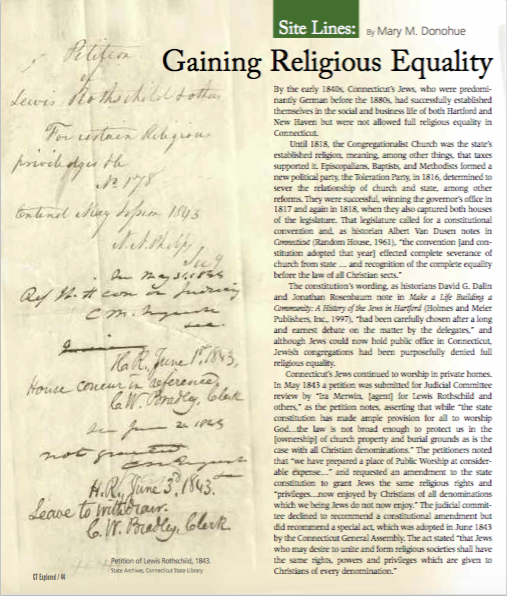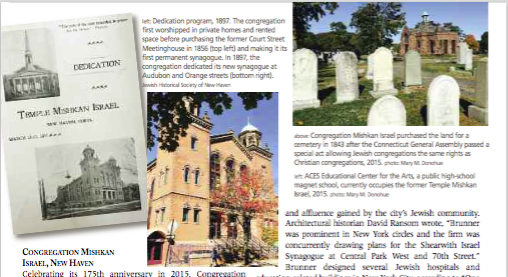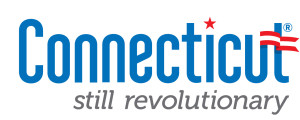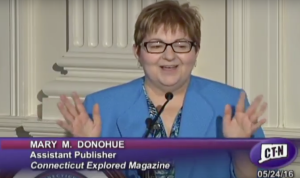By Mary M. Donohue
(c) Connecticut Explored, Inc., Spring 2016
Subscribe/Buy the Issue!
 By the early 1840s, Connecticut’s Jews, a group that was predominantly German before the 1880s, had successfully established themselves in the social and business life of both Hartford and New Haven but were not allowed full religious equality in Connecticut.
By the early 1840s, Connecticut’s Jews, a group that was predominantly German before the 1880s, had successfully established themselves in the social and business life of both Hartford and New Haven but were not allowed full religious equality in Connecticut.
Until 1818, the Congregational Church was the state’s established religion, meaning, among other things, that taxes supported it. Episcopalians, Baptists, and Methodists formed a new political party, the Toleration Party, in 1816, determined to sever the relationship of church and state, among other reforms. They were successful, winning the governor’s office in 1817 and again in 1818, when they also captured both houses of the legislature. That legislature called for a constitutional convention and, as historian Albert Van Dusen notes in Connecticut (Random House, 1961), “the convention [and constitution adopted that year]effected complete severance of church from state … and recognition of the complete equality before the law of all Christian sects.”
The constitution’s wording, as historians David G. Dalin and Jonathan Rosenbaum note in Make a Life Building a Community: A History of the Jews in Hartford (Holmes and Meier Publishers, Inc., 1997), “had been carefully chosen after a long and earnest debate on the matter by the delegates,” and although Jews could now hold public office in Connecticut, Jewish congregations had been purposefully denied full religious equality.
Connecticut’s Jews continued to worship in private homes. In May 1843 a petition was submitted for Judicial Committee review by “Ira Merwin for Lewis Rothschild and others,” as the petition notes, asserting that while “the state constitution has made ample provision for all to worship God…the law is not broad enough to protect us in the [ownership]of church property or burial grounds as is the case with all Christian denominations.” The petitioners noted that “we have prepared a place of Public Worship at considerable expense…” and requested an amendment to the state constitution to grant Jews the same religious rights and “privileges…now enjoyed by Christians of all denominations which we being Jews do not now enjoy.” The judicial committee declined to recommend a constitutional amendment but did recommend a special act, which was adopted in June 1843 by the Connecticut General Assembly. The act stated “that Jews who may desire to unite and form religious societies shall have the same rights, powers and privileges which are given to Christians of every denomination.”
Congregation Mishkan Israel, New Haven
Celebrating its 175th anniversary in 2015, Congregation Mishkan Israel was founded in 1840 by approximately 20 families. As soon as the new law passed, the congregation purchased a plot of land in Westville for a cemetery that is still in use today. They officially designated the room over the Heller and Mandelbaum store as their synagogue. Not everyone was happy with this. As noted on Congregation Mishkan Israel’s website (cmihamden.org), the New Haven Register observed (author and date unknown), “Whilst we have been busy converting the Jews in other lands, they have outflanked us here, and effected a footing in the very centre of our own fortress, strange as it may sound, it is nevertheless true that a Jewish synagogue has been established in the city.”
 The growing congregation moved to rented space on the corner of State and Chapel streets in 1849. An unexpected bequest of $5,000 in 1854 from the Rhode Island philanthropist Judah Touro made it possible for the congregation to move again, this time by purchasing the former Court Street Meetinghouse of the Third Congregational Church. It was dedicated as a synagogue on July 11, 1856.
The growing congregation moved to rented space on the corner of State and Chapel streets in 1849. An unexpected bequest of $5,000 in 1854 from the Rhode Island philanthropist Judah Touro made it possible for the congregation to move again, this time by purchasing the former Court Street Meetinghouse of the Third Congregational Church. It was dedicated as a synagogue on July 11, 1856.
Forty years later, the congregation decided to construct a new building on a lot it purchased on the corner of Audubon and Orange streets. (Congregation Beth Israel’s 1876 synagogue in Hartford was the first built in Connecticut; see “Charter Oak Cultural Center” and “Making Their Presence Known,” Spring 2005.) Designed by the architectural firm of Brunner & Tryon in the renaissance revival style, the sophistication of the design of the beautiful and imposing building conveyed the prominence and affluence gained by the city’s Jewish community. Architectural historian David Ransom wrote, “Brunner was prominent in New York circles and the firm was concurrently drawing plans for the Shearwith Israel Synagogue at Central Park West and 70th Street.” Brunner designed several Jewish hospitals and education-related buildings in New York City, according to “One Hundred Years of Jewish Congregations in Connecticut: 1843-1943,” in Connecticut Jewish History (Vol. 2, No. 1., Jewish Historical Society of Greater Hartford).
The magnificent 1897 building was home until the now 700-family-strong congregation moved to a new synagogue in Hamden in 1960. Governor Abraham Ribicoff, the state’s first Jewish governor, gave the keynote address at the building’s dedication. The original building is now part of the ACES Educational Center for the Arts, a public high school magnet school.
 Mary M. Donohue is an architectural historian. A frequent contributor to Connecticut Explored, she serves as its assistant publisher.
Mary M. Donohue is an architectural historian. A frequent contributor to Connecticut Explored, she serves as its assistant publisher.
Connecticut Explored received support for this publication from the State Historic Preservation Office of the Department of Economic and Community Development with funds from the Community Investment Act of the State of Connecticut.
Explore!
VIDEO
“The 1843 Petition: Gaining Religious Freedom for Connecticut Jews” 
Mary Donahue of Connecticut Explored, University of Hartford’s Dr. Bilal Dabir Sekou, and Connecticut’s State Historian Dr. Walter Woodward. Recorded on May 24, 2016 at Connecticut’s Old State House in downtown Hartford.
“Charter Oak Cultural Center,” Summer 2005
“Faith Amidst the Fields: Connecticut’s Country Synagogues,” Winter 2010-2011
“Making their Presence Known: Jews in Hartford,” Summer 2005
VISIT
ACES Educational Center for the Arts, 380 Orange Street, New Haven. The building was built for Congregation Mishkan Israel in 1897.
Charter Oak Cultural Center, 21 Charter Oak Avenue, Hartford. First building built as a synagogue in Connecticut, for Temple Beth Israel, 1876.
